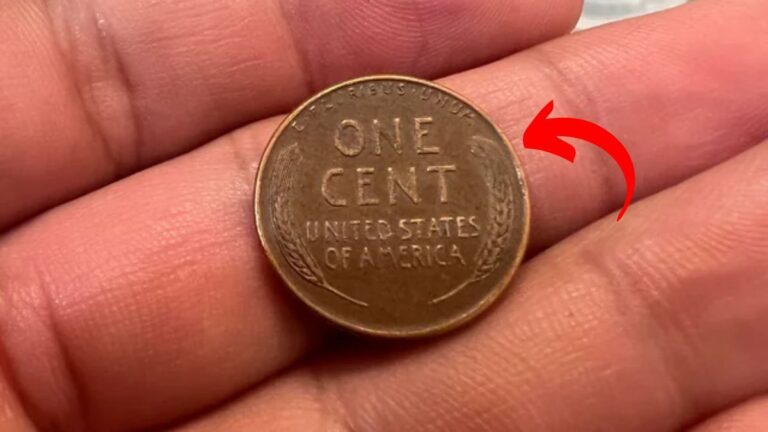The Lincoln Wheat Penny Valued at $9.7 Million — Still Hiding in Pocket Change?
Could a penny in your pocket be worth a fortune? Collectors are scrambling, and here’s why you might want to check your spare change.
A Penny from the Past That’s Turning Heads
It’s a regular Tuesday morning. You stop at your local coffee shop, pay with cash, and receive a few coins in change — nothing unusual. But what if one of those pennies, long ignored and gathering dust in wallets and jars across America, could be worth nearly $10 million? That’s no typo. A rare Lincoln Wheat Penny, believed to be still floating in general circulation, has stunned numismatists and everyday collectors alike with a jaw-dropping valuation of $9.7 million.
The big question: could one of these elusive pennies be lying forgotten in your drawer?
What Makes This Penny So Special?
It’s not just any Lincoln Wheat Penny. The coin in question is an exceptionally rare 1943 bronze wheat penny, minted by mistake during World War II. Most pennies made in 1943 were struck in zinc-coated steel due to wartime copper shortages. However, a few bronze planchets — leftover from 1942 — somehow made it into the press.
Only about 10 to 15 authentic examples are known to exist, and each time one surfaces, it sends ripples through the coin-collecting community.
What’s more intriguing is that one of these coins was discovered in circulation by a teenager in 1947, tucked among regular change. That same coin, verified by experts and preserved in pristine condition, was recently auctioned for $9.7 million — a record for a one-cent piece.
Still in Circulation? Yes, Possibly.
You might wonder, “How can something so rare still be out there?” Surprisingly, it’s not as far-fetched as it sounds.
Many people don’t realize the value of old coins. A 1943 bronze penny looks almost identical to an ordinary 1943 steel penny unless you know what to look for. Over the decades, several of these rare coins have been misidentified, passed off in piggy banks, or simply lost in plain sight.
According to Heritage Auctions, one of the world’s largest coin dealers, there’s strong evidence to suggest at least one unverified 1943 bronze penny is still in public hands, and possibly, still in everyday use.
“Every so often, we get inquiries or photos from someone who finds an unusual penny,” says Mark Langston, a senior coin specialist. “One of these could very well be the real deal — worth millions.”
The Great Penny Hunt Begins
Since news of the $9.7 million sale broke earlier this year, coin collectors — both seasoned and new — have launched what some are calling the “Great Penny Hunt.” Social media groups are filled with hopeful posts, YouTube is flooded with tutorials on how to identify rare pennies, and coin shops across the country are seeing a surge in visitors.
Even schools have jumped in, with teachers encouraging kids to bring old coins from home for show-and-tell, just in case a hidden treasure is discovered.
Want to check your coins? Grab a magnet — if your 1943 penny sticks, it’s steel and common. If it doesn’t, and it looks bronze or copper-colored, you might be holding history. But don’t celebrate just yet; counterfeit versions abound. Experts recommend having the coin authenticated by a certified numismatist or submitting it to PCGS or NGC, the two top grading companies in the U.S.
The Emotional Allure of Old Money
There’s something almost romantic about the idea that a forgotten penny could change your life. It plays into our love for hidden treasures and overlooked riches. After all, coins like the 1943 bronze penny carry not just monetary value, but history — minted during one of the most turbulent times in modern history, lost in the shuffle, and now rediscovered decades later.
For many collectors, the thrill isn’t just in the value, but the story. The teenager who found one in 1947 became a local legend. The recent owner? A retired mechanic who unknowingly kept it in a sock drawer for over 30 years.
Why It Matters Now
In a world increasingly driven by digital payments, physical coins are becoming relics of the past. But stories like this remind us that what’s old can still surprise us — and sometimes, be incredibly valuable.
With inflation rising and economic uncertainty looming, collectibles and rare coins have become a unique form of investment. While most coins aren’t worth more than face value, a handful, like the Lincoln Wheat Penny, are worth their weight in gold — and then some.
Final Thoughts: Could You Be Next?
So the next time you receive a handful of coins, pause before tossing them into your car’s cup holder. That unassuming penny might just be a rare artifact, carrying the weight of history and a potential multi-million-dollar payday.
As collectors continue their hunt and stories of everyday people striking it rich circulate online, one can’t help but wonder — what treasures are we overlooking in our rush to the future?
Maybe, just maybe, your fortune is hiding in plain sight.
